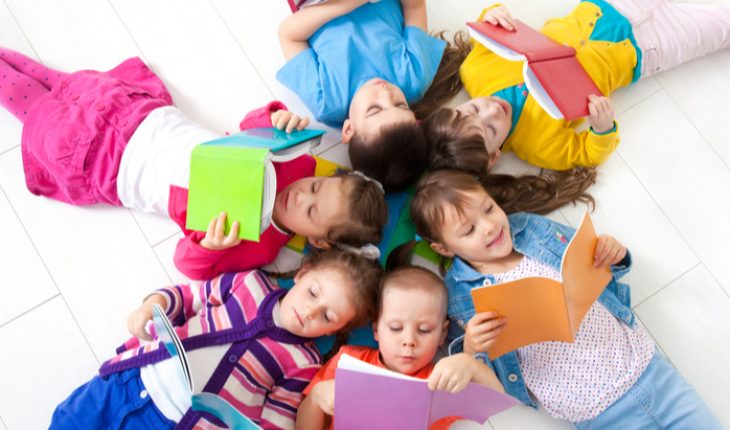It is never too early to start the process of learning to read, and parents play a crucial role. ‘As soon as a baby is born, you can start to show them picture books,’ says Clare Bolton, manager of Words for Life, a project run by the Literacy Trust to help parents develop children’s communication and literacy skills from birth to the age of 11. ‘It makes a huge difference to a child’s development if you can spare 10 minutes a day to read to your child. The early years are key and 70 per cent of a child’s brain develops by the time he or she is three.’
Although there are milestones, Bolton says there is no set formula. “It shouldn’t be a race. Every child develops at a different rate, but by 18 months old your baby may be using words and responding to your questions.”
By the age of six, most children should be able to read simple sentences, but some children will take longer. ‘The most important thing is to make sure that reading is fun and doesn’t become a chore,’ she explains. National Literacy Trust research in 2011 found that young people who enjoy reading very much are more likely to read above the expected level for their age.
Another important factor is availability of books. One child in three in the UK does not own a single book of their own.
The local library can be a rich resource when children can borrow books to take home, or just browse through books on the shelves. Libraries also arrange story telling and activities based around reading like the annual Summer Reading Challenge organised by The Reading Agency. ‘Get your child a free library card and take advantage of what is on offer,’ advises Bolton. Sadly, 2012 research commissioned by The Reading Agency and carried out by Ipsos MORI found that less than two-thirds of parents (61%) of primary school age children have registered their children at their local library, or borrowed books to encourage their children to read.
Online books and the Internet is another valuable resource when it comes to familiarising young children with words and sentences. In fact, according to a recent study by the Literacy Trust, online reading has now overtaken reading in print for children aged between 8-16. Bolton believes that choice of reading format is a good thing, but points out that younger children in particular still need all the sensory stimulation that comes from turning the pages of a good book. ‘What we know is that children who only read online are generally less good readers. Also, a real book has textures, sounds and even smells that all contribute to the reading experience,’ she says.
Parents can also read to their children from recipe books, magazines or whatever printed material is to hand. It helps if the child is particularly interested in the subject. ‘Kids who love football are more likely to be interested in stories about football for example,’ says Bolton. If your child loves dinosaurs, find some books which feature dinosaurs, starting with Harry and the Dinosaurs and moving up to detailed encyclopaedias about the Jurassic period.
And what about children who struggle? Dyslexia, which causes difficulties with learning to read fluently, is thought to be one of the most common learning difficulties. It is estimated that 4%-8% of all schoolchildren in England have some degree of dyslexia. These children can still learn to love reading, with proper support and strategies in place.
“Reading is for everyone and it makes a huge difference to their quality of life and even their future success,” says Bolton. A wealth of research shows the crucial significance of children reading independently and for enjoyment. It has even been shown to be more important for children’s educational success than their family’s socio-economic status (OECD, 2002).
What about phonics?
There are different schools of thought about what is the best way to read but most schools now adopt a method of phonics. This is a system based on teaching basic letter sounds and more complicated ones like ‘sh’, ‘ch’ and ‘oi’ as well as what letters sound like when they are blended together. There are also key words which must be learned by heart. Children should be able to decode these sounds and read simple sentences by age 6.
Some experts believes that a mixed method of teaching is preferable, using phonics alongside more informal methods including providing a text rich environment for the child. “Phonics does give very good results in the classroom but it is not the only way to teach reading,’ explains Bolton. ‘A lot of schools offer support for parents who want to help their child to read using phonics but need help themselves to understand the method. There are also lot of online resources you can use.’
Top tips for making reading fun
Make reading active
Get your children to “act out” what they have read, and pretend to be book characters – you can join in too! For younger children, after reading a book, draw the characters together, or even make puppets and put on a show.
Involve the whole family
Get older children to read to younger ones, and get dads, aunties and grandparents involved too. Boys in particular benefit from male reading role models.
Experiment with genres
Try a variety of books and authors to see what suits your child’s taste. If they have a particular hobby visit the library together to find relevant books that they will enjoy.
Let your child choose
If your child has chosen a book themselves they are much more likely to actually read it. Don’t forget that comics, magazines and non-fiction books are all valid forms of reading too.
Praise your child’s efforts
Be encouraging when your child reads aloud. It’s okay to make mistakes, it’s how you learn, and reading is meant to be fun!
www.wordsforlife.org.uk
- Biden Declines Second Term: Health Concerns - 23rd July 2024
- New catheter coating stops bacteria cells from swarming - 10th June 2024
- AI-designed catheters could dramatically reduce urinary tract infections - 10th June 2024






